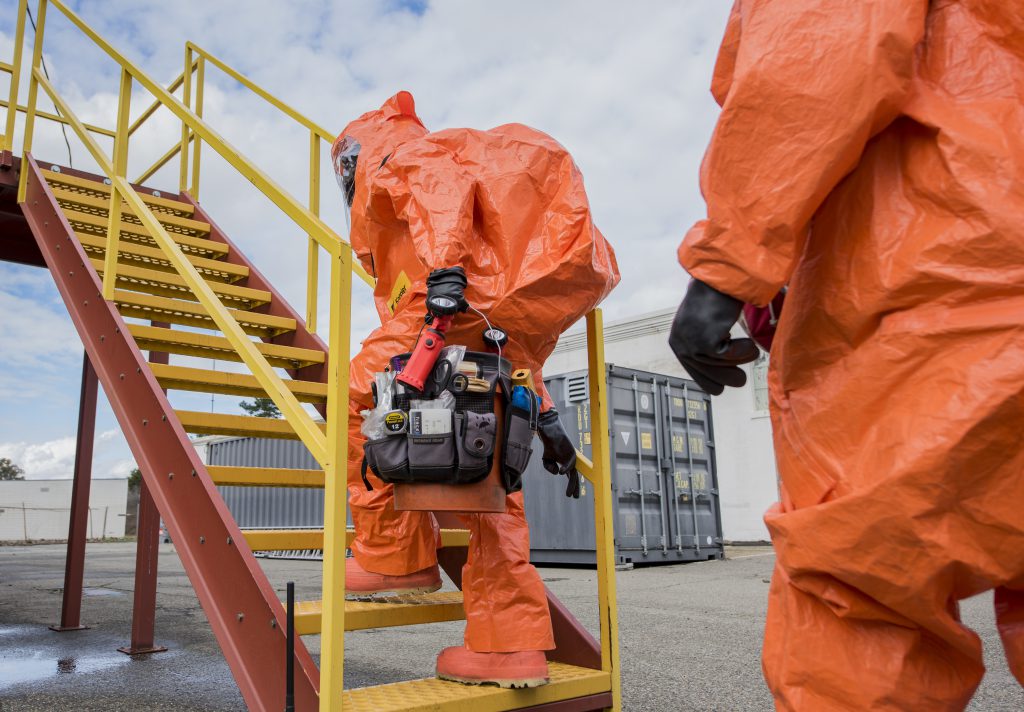Idaho Guard partners in multi-agency all-hazards exercise

Crystal Farris/Idaho Military Division Public Affairs
The Idaho National Guard’s 101st Weapons of Mass Destruction Civil Support Team partnered with CSTs from 11 other states, along with more than ten different local and federal agencies and organizations, during Exercise ORCA 2021, to train in responding to various hazardous material incidents throughout Alaska, May 17 to 20.
The all-hazards exercise that took place simultaneously in Anchorage, Matanuska-Susitna Valley and Seward, involved the largest turnout of CST participants to an ORCA exercise, helping the 101st CST and other emergency responders maximize training opportunities while testing interagency coordination, interoperability and response abilities.
“It is important that we practice deployment operations and integration with other teams through exercises to ensure a rapid, timely and integrated response to a real-world threat,” said Capt. Jessica McBride, 101st CST survey team leader.
During the exercise, CSTs coordinated and worked through various scenarios, including identifying illicit and dangerous substances and responding to simulated attacks and disasters.
The 101st CST responded to the Anchorage Fire Training Center, which for the exercise simulated a residential six-story apartment building with approximately 20 rooms where terrorists prepared weapons of mass destruction.
“We were called in to conduct a relief-in-place of Alaska’s 103rd CST after it established perimeters with safe zones and threat zones, and then started site characterization of the building itself,” said Capt. John Bomsta, 101st CST operations officer. “We assisted in finishing the site characterization, describing what the building looked like and the possible threats we found. There was something to be found in every room and a lot of area to cover.”
Once on scene, the 101st CST worked through the night for approximately 12 hours continuing site characterization and field analysis of the building. During that time, it located five lab setups including a drug lab, a homemade explosives lab and a potential nerve agent lab. Rooms also had trips wires, motion detectors and confined spaces.
“We were able to provide field analysis of what we saw in the building in order to push information up to higher, which in this case was the FBI as incident command, on what they should look for at other sites,” said Bomsta. “As the story developed, other CSTs were located as far south as Seward, also responding to various terrorist threats in their vicinities.”
CSTs from Alaska, California, Connecticut, Colorado, Ohio, Oregon, Rhode Island, South Carolina, South Dakota, Washington and Wisconsin attended, in addition to other National Guard units such as Colorado’s 8th CBRN Enhanced Response Force-Package and members of Alaska’s 176th Civil Engineer Squadron.
Local agencies and organizations included Alaska Department of Homeland Security and Emergency Management, Matanuska-Susitna Emergency Management, Alaska Department of Environmental Conservation, Major Marine Tours, Alaska Railroad, Anchorage Fire Department, Alaska State Emergency Operations Center, University of Alaska-Anchorage, Port of Seward and the Port of Alaska-Anchorage.
“The exercise was designed with scenarios based on what all the participating CSTs had communicated they wanted to see and tasks they wanted to accomplish,” said Maj. Robert Grimes, 101st CST commander. “Our team was able to achieve various objectives, including integrating with other CSTs and civil responders to build those relationships and learn each other’s capabilities and limitations.”
Unlike most other military units, CSTs work almost entirely alongside civilian agencies, including regional hazardous response teams, police, firefighters and other state or federal responders that function under an incident command system during emergency situations. Grimes said developing these partnerships make training scenarios like Exercise ORCA 2021 critically important.
“What we do as an individual team is just one portion of what it takes overall to respond to a real-world event like this,” said Grimes. “We train to provide the best support we can to civil authorities in the event of a domestic chemical, biological, radiological or nuclear high-yield explosives incident.”
As one of 57 teams located in every U.S. state and territory, the 101st CST is composed of 22 highly skilled full-time Army and Air National Guardsmen trained to provide incident and disaster management by identifying CBRNE agents and substances, assessing current or projected consequences, advising on response measures and assisting with appropriate request for additional follow-on state and federal military forces.
As part of Idaho’s emergency response structure, the unit is prepared and ready to respond at any time to hazardous incidents that threaten the community, state and nation and are often called upon state-side to assist in public safety events including sports games and governor inaugurations.
 Official Government Website
Official Government Website